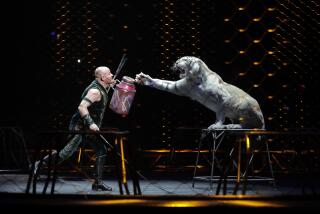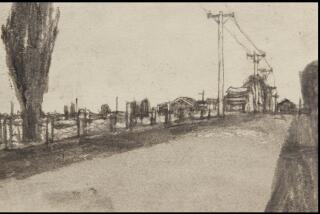Sideshow No Longer
- Share via
CALABASAS — Be amazed! Step this way! Meet twins bound by a pound of flesh! Watch as Priscilla, the monkey girl, hangs by her feet! See Neandro, the missing link! Crane your neck at Queen Kong, the 400-foot gorilla!
No, the circus is not in town--only the “World’s Strangest Oddities” as depicted by circus artist Johnny Meah. His sideshow banners, housed at the Smithsonian Institute and other galleries, have become a novelty even as old- fashioned circuses have turned into white elephants.
Meah is visiting the San Fernando Valley from his home in Tampa, Fla., to open a permanent display of his work at a Calabasas restaurant. Patrons of the Sagebrush Cantina can gaze at the portrait of “Suzie the Elephant-Skinned Girl” and dozens of other works.
The banners were designed as advertisements to lure circus patrons to often lurid sideshow attractions that charged separate admission. The works, some longer than 100 feet, have now become moneymakers.
Meah, a raspy-voiced chain smoker, said his mother wanted him to be a priest. But his father, an editorial cartoonist for several newspapers, including the Hartford Courant, had different plans for him.
Meah’s father sparked his interest in the circus as a youngster by taking him to fairs and amusement parks to help draw posters, he said.
When he was 14, Meah spent his summer vacation with a circus, studying to be a clown and sketching under the tutelage of Hugo Zachinni, an accomplished artist and the patriarch of his family’s human cannonball act.
Meah worked as a clown for several circuses while still in high school, in addition to taking drawing classes at the Rhode Island School of Design. He also learned sword swallowing, fire eating and acrobatics.
“I was like a kid in a candy store. I was living my dream,” he said.
Throughout his circus career, Meah moonlighted as a sign maker, but in 1957 a sideshow manager and female impersonator named Leo/Leola changed his life for good.
“He could marry a woman--she could marry a man,” said Meah, describing the manager in his best ringleader voice. “Her real name was Homer Tracy.”
Leola had sent some of Meah’s banners to David “Snap” Wyatt, a well-known circus banner artist. Wyatt lauded Meah’s work and Leola decided to hire Meah as the sideshow “show painter.”
Show painting was basically outdoor advertising. Before each circus, organizers would “hold the door,” preventing crowds from entering the main tent on time, Meah said. While the crowd waited, an announcer would tell everyone to visit the sideshow.
Meah’s banners showed the way.
“I measured my banners at 110 feet so the average person has to take 33 steps to walk by them,” Meah said. “You are trying to make a banner that is going to stop them, intrigue them and motivate them to want to buy a ticket and see the things portrayed on the banner.”
Torture and nude acts were the most popular, he said.
Meah worked as an artist throughout the 1960s and 1970s, traveling the world with Ringling Bros., Mills Bros., the Royal American Circus and Circus USA. But circuses faltered during the 1980s as costs increased and revenues dried up.
“You couldn’t paint for circuses anymore because there were none,” he said.
Just as circuses withered away, however, Meah discovered lucrative new clients: art collectors.
After a magazine featured his work, Meah began fielding calls from museums that wanted a sideshow of their own. In addition to showings at the American Art Museum in Washington, D.C., Meah’s work is being shown in the Roger Brown Gallery in Chicago.
But Meah remembers when his banners were not in such high demand. “I used to sell them for 50 cents each. There was one time when I stopped an oil leak on a truck with one of them.”
Now Meah sells his banners for $1,500 to $10,000 apiece.
“This is history,” he said.
More to Read
The biggest entertainment stories
Get our big stories about Hollywood, film, television, music, arts, culture and more right in your inbox as soon as they publish.
You may occasionally receive promotional content from the Los Angeles Times.










